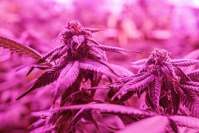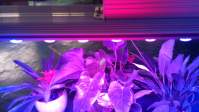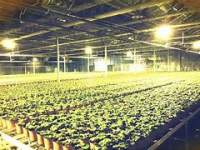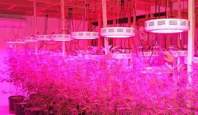Light is a necessary condition for the normal growth of green plants. Just as humans obtain energy from food, plants obtain energy from light through photosynthesis. Now that the artificial light source LED plant light supplement light can also give plants good growth, people will be curious: How does the light of 1000w LED plant light affect the growth of plants?
Different wavelengths of light
Different wavelengths of 1000w LED plant lights have different effects on plant growth. Especially in different growth stages, different wavelengths of light will be better for the growth of plants.
The light of 1000wLED plant light with a wavelength between 280-315nm has little effect on the morphology and physiological process of plants; the chlorophyll in plants has little light absorption between 315-400nm, has an effect on the photoperiod, and prevents the elongation of the stem ; 400-520nm is blue-violet light. In the process of photosynthesis of plants, the absorption ratio of chlorophyll and carotenoids is the largest, and the impact on photosynthesis is also the greatest; the absorption rate of green light between 520-610nm is not high by plants; The absorption rate of orange light is very low. But the red-orange light has a significant influence on photosynthesis of the photoperiod effect. Light with a wavelength of 720-1000nm (FR, that is, far-infrared light) has a low absorption rate in plants,
The red light and blue light in 1000wLED plant lights have the greatest impact on the photosynthesis of plants, so many people now use 1000wLED plant lights to supplement the light. When natural light is insufficient, red and blue lights are most supplemented. In 1000wLED plant lights, red and blue The ratio can also be adjusted as needed.
Intensity of light
According to botany theory, a certain intensity of light stimulation can make plants produce effective photosynthesis. Proper light intensity can promote the smooth progress of photosynthesis and provide enough material and energy for plant growth. According to different plant growth characteristics, the light intensity suitable for plant photosynthesis is generally 10000-30000 lux, so the light intensity is also within this range when using 1000w LED plant lights.
When the light intensity of vegetable plants is insufficient, in addition to reducing the photosynthesis intensity, it will also affect the morphological and anatomical changes such as leaf size, thickness, mesophyll structure, internode length, and stem thickness. These will affect the growth and development of vegetable plants, and affect the yield and quality. However, the emergence of 1000wLED plant lights can realize the controllability of the planting environment. By adjusting the distance and power of the 1000wLED plant lights from the vegetable plants, the light intensity needs of the vegetable plants can be met.
Light irradiation time adjustment
The length of illumination time is closely related to the photoperiod phenomenon of plants. The phenomenon that plants control flowering by sensing the length of day and night is called photoperiod phenomenon, that is, the phenomenon in which plants control their own physiological responses by sensing the length of day and night. The alternation of light and dark between day and night has a significant impact on plant development, especially flowering. In addition to inducing flowering, the illumination of 1000wLED plant lights can also affect the elongation of plant flower stems, the formation of tubers and tubers, bud dormancy and leaf fall.
According to the different response of plants to the photoperiod, plants can be divided into long-day plants, short-day plants and intermediate plants.
Long-day plants need more than 14 hours of light from 1000w LED plant lights to activate their germination, vegetation and flowering. Wheat, cabbage and spinach are long-day plants.
Short-day plants require less light time, usually 8 to 12 hours during plant growth. They have more demand for long night conditions. Within a certain range, the longer the dark period, the shorter the flowering period.
Intermediate plants: In the process of growing blindness, plants have no strict requirements on the length of light. As long as other environmental conditions are suitable, they can bloom in different lengths of sunlight. Tomatoes, cucumbers and string beans all fall into this category.
Growers use 1000w LED plant lights with dimming control in order to more easily change the lighting time, combine the photoperiod of the plants to fill in the light, and bring better benefits.
Light quality ratio
For major plant breeding and planting companies or LED plant light plant lighting service providers, the parameters of the light quality ratio are still under study, and the specific application needs to consider other local factors at the time.
At present, everyone refers to the data based on the ratio of sunlight spectrum, and adjusts flexibly according to the field planting situation and crop types and functions. The ratio of red to blue light of the sun is about 6-8:1. People refer to this to conclude that flower foliage or leaf viewing For vegetable-like plants, the configuration should be less than 6-8:1, so that the blue light is a little bit more, and the blue light has a promoting effect on the growth of plant leaves. For flower viewing, choose 6-8:1 or more for supplementary light during the flowering period, so that there will be more red light. Red light has a significant effect on the flowering and fruiting of plants. For other growth stages, follow the sunlight reference ratio, and choose 6-7:1.
The same plant has different requirements for light quality and light quantity in different growth periods. Plants can use cheaper LED plant lights during the seedling period, and use high-power 1000w LED plant lights when the plants bloom and bear fruit. The crops grow at an extremely fast growth rate and produce excellent quality.






